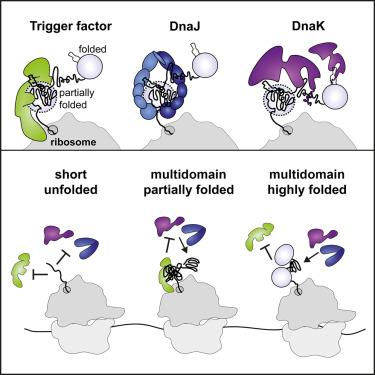Our official English website, www.x-mol.net, welcomes your
feedback! (Note: you will need to create a separate account there.)
Mechanism of chaperone coordination during cotranslational protein folding in bacteria
Molecular Cell ( IF 14.5 ) Pub Date : 2024-06-21 , DOI: 10.1016/j.molcel.2024.06.002 Alžběta Roeselová 1 , Sarah L Maslen 2 , Santosh Shivakumaraswamy 1 , Grant A Pellowe 1 , Steven Howell 2 , Dhira Joshi 3 , Joanna Redmond 3 , Svend Kjær 4 , J Mark Skehel 2 , David Balchin 1
Molecular Cell ( IF 14.5 ) Pub Date : 2024-06-21 , DOI: 10.1016/j.molcel.2024.06.002 Alžběta Roeselová 1 , Sarah L Maslen 2 , Santosh Shivakumaraswamy 1 , Grant A Pellowe 1 , Steven Howell 2 , Dhira Joshi 3 , Joanna Redmond 3 , Svend Kjær 4 , J Mark Skehel 2 , David Balchin 1
Affiliation

|
Protein folding is assisted by molecular chaperones that bind nascent polypeptides during mRNA translation. Several structurally distinct classes of chaperones promote folding, suggesting that their activities are coordinated at the ribosome. We used biochemical reconstitution and structural proteomics to explore the molecular basis for cotranslational chaperone action in bacteria. We found that chaperone binding is disfavored close to the ribosome, allowing folding to precede chaperone recruitment. Trigger factor recognizes compact folding intermediates that expose an extensive unfolded surface, and dictates DnaJ access to nascent chains. DnaJ uses a large surface to bind structurally diverse intermediates and recruits DnaK to sequence-diverse solvent-accessible sites. Neither Trigger factor, DnaJ, nor DnaK destabilize cotranslational folding intermediates. Instead, the chaperones collaborate to protect incipient structure in the nascent polypeptide well beyond the ribosome exit tunnel. Our findings show how the chaperone network selects and modulates cotranslational folding intermediates.
更新日期:2024-06-21











































 京公网安备 11010802027423号
京公网安备 11010802027423号